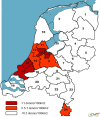Potential of Donation After Unexpected Circulatory Death Programs Defined by Their Demographic Characteristics
- PMID: 34966838
- PMCID: PMC8710346
- DOI: 10.1097/TXD.0000000000001263
Potential of Donation After Unexpected Circulatory Death Programs Defined by Their Demographic Characteristics
Abstract
Background: Donation after unexpected circulatory death (uDCD) donors are often suggested to increase the number of donor organs. In 2014, a uDCD protocol was implemented in three transplant centers in the Netherlands which unfortunately did not result in additional transplantations. This study was initiated to identify demographic factors influencing the potential success of uDCD programs.
Methods: Dutch resuscitation databases covering various demographic regions were analyzed for potential donors. The databases were compared with the uDCD implementation project and successful uDCD programs in Spain, France, and Russia.
Results: The resuscitation databases showed that 61% of all resuscitated patients were transferred to an emergency department. Age selection reduced this uDCD potential to 46% with only patients aged 18-65 years deemed eligible. Of these patients, 27% died in the emergency department. The urban region of Amsterdam showed the largest potential in absolute numbers (52 patients/y). Comparison with the uDCD implementation project showed large similarities in the percentage of potential donors; however, in absolute numbers, it showed a much smaller potential. Calculation of the potential per million persons and the extrapolation of the potential based on the international experience revealed the largest potential in urban regions.
Conclusions: Implementation of a uDCD program should not only be based on the number of potential donors calculated from resuscitation databases. They show promising potential uDCD percentages for large rural regions and small urban regions; however, actual numbers per hospital are low, leading to insufficient exposure rates. It is, therefore, recommendable to limit uDCD programs to large urban regions.
Copyright © 2021 The Author(s). Transplantation Direct. Published by Wolters Kluwer Health, Inc.
Conflict of interest statement
The authors declare no conflicts of interest.
Figures




References
-
- World Health Organization, Spanish Transplant Organization. Global Observatory on Donation and Transplantation. Available at www.transplant-observatory.org. Accessed January 2019.
-
- Lomero M, Gardiner D, Coll E, et al. ; European Committee on Organ Transplantation of the Council of Europe (CD-P-TO). Donation after circulatory death today: an updated overview of the European landscape. Transpl Int. 2020;33:76–88. - PubMed
-
- Venema LH, Brat A, Nijkamp DM, et al. . Factors that complicated the implementation of a program of donation after unexpected circulatory death of lungs and kidneys. Lessons learned from a regional trial in the Netherlands. Transplantation. 2019;103:e256–e262. - PubMed
-
- Zijlstra JA, Stieglis R, Riedijk F, et al. . Local lay rescuers with AEDs, alerted by text messages, contribute to early defibrillation in a Dutch out-of-hospital cardiac arrest dispatch system. Resuscitation. 2014;85:1444–1449. - PubMed
LinkOut - more resources
Full Text Sources

